A study on the evolutionary history of a lineage of bugs, by colleagues from Argentina and the Smithsonian was recently published in Zoological Journal of the Linnean Society. It is based in part on paratypes and other specimens collected by Dr. Jane O’Donnell that are deposited in our insect collection.
Dellapé P.M., M.C. Melo & T.J. Henry. 2016. A phylogenetic revision of the true bug genus Heraeus (Hemiptera: Rhyparochromidae: Myodochini), with the description of two new genera and 30 new species. Zoological Journal of the Linnean Society 177: 29–134. pdf
The abstract reads: Prior to this study, the genus Heraeus Stål, 1862 included 14 species, all of which are restricted to the Western Hemisphere. Three species are known from the Nearctic Region, nine from the Neotropical Region, and two mainly tropical elements are distributed in both regions. In this contribution, we consider Heraeus cincticornis Stål, 1874 a junior synonym of Heraeus elegans (Walker, 1873), select a lectotype for Heraeus coquilletti Barber, 1914, and neotype for Lygaeus triguttatus Guérin-Méneville, 1857, and describe 28 new species. In addition, the two new genera, Baranowskiobius gen. nov., to include H. elegans (Baranowskiobius elegans comb. nov.) and two new species, and Paraheraeus gen. nov., to include Heraeus eximius Distant, 1882 (Paraheraeus eximius comb. nov.), are described. Previously described species and new taxa are (re)described and illustrated, including male genitalia. Scanning electron micrographs, general habitus photographs, and distribution maps are included for all species studied. A phylogenetic analysis comprising 46 terminal taxa and 50 morphological characters was performed, and five species groups were hypothesized, including the coquilletti, caliginosus, guttatus, illitus, and plebejus groups. All known species of Heraeus and the new genera are included in the phylogenetic analysis. The type species of the genera Myodocha Latreille, 1807, Orthaea Dallas, 1852, and Paisana Dellapé, 2008 are used as out-groups.
 EEB5500
EEB5500